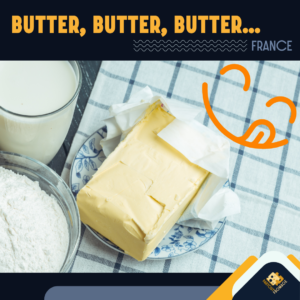Yesterday, on my Instagram I promised to share a list of dairy products my students and I have been studying. Cheese is surely our main favourite, and we dedicate a significant portion of our lessons to it. However, there are other products made from milk too. You can find all of these at a good fromagerie shop.
Shall we begin?
✔ The first dairy product is milk itself. It comes in different fat content and undergoes various processing methods (that my students must learn by heart). In France, even raw milk (with a very short shelf life) can legally be sold. Knowing how to store and label all those milk varieties is important.
✔ The second product on our list is cream. We have regular liquid cream (called “crème” in France) and thickened cream (known as “crème épaisse” and especially loved by the French). I can’t imagine French cuisine without creams.
✔ Third, we have animal butter, another main thing in any French kitchen. I will write a separate post about it, as it’s a more complex topic. For now, let’s move on to the next item.
✔ The fourth category includes various yogurts and acidophilus milk products. I mention them separately because, according to French law, any yogurt is considered acidophilus milk, but not all acidophilus milk is yogurt. Formally, yogurt is made by adding two specific bacteria to it: Lactobacillus bulgaricus and Streptococcus thermophilus. If these bacteria are present and thriving, you’re eating yogurt. Otherwise, it’s not yogurt, but probably still delicious 😉. Kefir, fermented baked milk, and different curds fall into this category. They are known as “lait fermenté.”
✔ Let’s move on to the fifth item. This one might be difficult to explain to non-French people. It’s about why soft and liquid “cream” is called cheese. Cheese is supposed to be hard, isn’t it? In France, we love and consume a lot of “fromage blanc” or “fromage frais” (fresh/white cheese). Although it lacks ageing, it is still considered cheese with varying degrees of softness. A small amount of rennet (a thickening agent) can be added during production, but the curd should primarily consist of lactic acid. If rennet is not added at all, the product returns to the fourth item, acidophilus milk. It can be confusing and complicated!
However, that’s almost all. ✔ Only dairy desserts are left. They are also available in cheese shops, with countless recipes for them. You might come across riz au lait (a rice pudding that evokes nostalgic memories of grandma for many French people), crème brûlée, or various milk mousses and creams. Most of these delicacies are made on-site, and each fromagerie has its own signature recipe. If you have the chance, don’t miss out on trying them!
So, as you can see, French fromageries offer a wide variety of dairy products and delicious milk. My lesson for both my students and you is over now, and I’m going to enjoy some “white cheese” with berries. Yum! 😋




